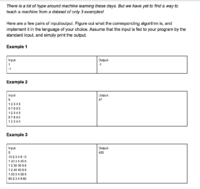MarkSpencer
New member
- Joined
- Aug 10, 2019
- Messages
- 1
Hello ,
I am i am trying to resolve a problem, can you please take a look :
There is a lot of hype around machine learning those days.But we have to find a way to teach machine from a dataset of only 3 examples.
Here are a few pairs of input/output.Figure out what the corresponding algorithm is.
I assume (not sure) that the first line of inputs is Matrix size
Thank you
Example1:
Input
1
-1
Output
-1
Example 2 :
Input
5
1 2 3 4 5
6 7 8 9 0
1 2 3 4 5
6 7 8 9 0
1 2 3 4 5
Output
47
Example 3 :
Input
6
10 2 3 4 5 10
1 20 3 4 20 6
1 2 30 30 5 6
1 2 40 40 5 6
1 50 3 4 50 6
60 2 3 4 5 60
Output
420
I am i am trying to resolve a problem, can you please take a look :
There is a lot of hype around machine learning those days.But we have to find a way to teach machine from a dataset of only 3 examples.
Here are a few pairs of input/output.Figure out what the corresponding algorithm is.
I assume (not sure) that the first line of inputs is Matrix size
Thank you
Example1:
Input
1
-1
Output
-1
Example 2 :
Input
5
1 2 3 4 5
6 7 8 9 0
1 2 3 4 5
6 7 8 9 0
1 2 3 4 5
Output
47
Example 3 :
Input
6
10 2 3 4 5 10
1 20 3 4 20 6
1 2 30 30 5 6
1 2 40 40 5 6
1 50 3 4 50 6
60 2 3 4 5 60
Output
420

